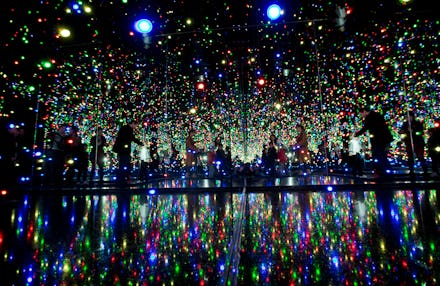How Instagram is Keeping Art Alive

The widespread use of smart devices (i.e. smartphones and tablets) in art institutions around the world — from the Met to the MoMA to the Louvre — has purists fuming. Tired of watching young people view Van Gogh through their camera app, some critics go so far as to argue that smartphones should be banned from museums altogether. Yet, while the use of smartphones at museums might seem troubling, their effect on the art world has been undeniably positive.
Selfie with Van Gogh's "Self Portrait with a Straw Hat" at the Metropolitan Museum of Art. Image credit: Flickr
In fact, according to a recent Pew Institute survey, 81% of museums and galleries believe the internet and social media play a crucial role in supporting the arts. After decades of scaring potential supporters away (and missing out on the youngest generation completely) with endless snail mail and telephone marketing, smartphones and social media are providing museums like New York's Metropolitan Museum of Art and Los Angeles' Getty Museum — each of which boast millions of Facebook, Twitter, Pinterest, and Instagram followers — a second chance at community-building.
Individual artists are also benefiting. When visitors post photos and videos online, they draw attention to exciting new installations and their creators. In New York City alone, this trend has played out three times in the last six months: Snapping and posting photos of James Turrell's "Aten Reign" became a rite of passage at the Guggenheim last summer, the popularity of Banksy's October residency in NYC was largely driven by his use of Instagram, and, for better or worse, the chance to capture a cosmic selfie played a big role in drawing crowds to Yayoi Kusama's show at the David Zwirner Gallery. Larger audiences and increased awareness of their work is great for these artists, and they have the omnipresence of smartphones to thank.
Instagram selfie taken in the "Infinity Mirrored Room — The Souls of Millions of Light Years Away," part of the Kusama exhibit at the David Zwirner Gallery
Instagram photo of the "Rain Room" exhibit at the Museum of Modern Art
Social sharing's impact is not limited to creating buzz, either. Smartphone-wielding patrons etch ephemeral new exhibits like Turrell's and Kusama's into digital history in a way that is both permanent (assuming the internet never shuts down) and accessible. They also liberate art from eras past; selfies with Rembrandts and Van Goghs lend currency and vitality to works of art that, before internet-enabled devices with cameras, were confined to the museums and art history books.
Instagram photos of James Turrell's "Aten Reign" at the Guggenheim
The democratization of photography and publishing is also fueling a debate over whether the hundreds of millions of photos and videos uploaded daily (yes, daily) constitute art. It is a concession that purists might hate to make. Yet, as long as there have been master artists there has also been crappy, imitative art work. How are the millions of attempts at artistry uploaded to social media every day any different? This question has the likes of Esquire and the Atlantic approaching the notion of selfies as art with earnestness that would have been surprising a few years ago.
There's no doubt about it: Internet-enabled devices are contributing to, not detracting from, art institutions, artists, and art itself. Purists will continue to resist, but ultimately smartphones no more reduce the museum experience than do traditional photography (often allowed in a museum's permanent collection), long lines, and crying babies.
As for the sentiment (often unsaid) that seems to run through it all — that teenagers snapping selfies alongside famous paintings affront the sanctity of art — that would seem to be a matter of taste. And isn't taste what art is all about?